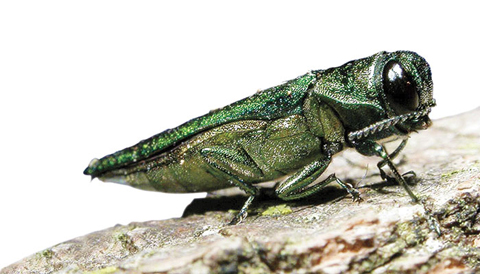Over the past decade, tens of millions of ash trees across North America have died because of a hungry green beetle named the emerald ash borer. “It’s a tsunami,” says Prof. Sandy Smith, who estimates that most of Toronto’s ash trees will be gone within five to 10 years.
Smith, dean of the Faculty of Forestry, is a forest entomologist who specializes in finding native, natural enemies of insect pests. She and PhD student Lucas Roscoe have identified a little-known, local parasite that feeds off – and kills – the emerald ash borer.
In collaboration with Canadian Forest Service researchers, Smith and Roscoe have gathered new data on the parasite, which could be used to protect areas with ash trees where the beetle has not yet arrived. Native to Asia, the emerald ash borer kills ash trees by laying its eggs under the bark. The hatched larvae then feed off the inner tissue of the tree, depriving it of water and nutrients. The ash borer has moved so quickly through the landscape that it will take some time before its natural predators catch up. In the meantime, “there will be a lot less ash,” says Smith.
Long-range planning is urgently needed, she says – both to diversify the province’s tree stock and manage the enormous costs of disposing of dead and dying trees. U of T has provided funding for two students in the Master of Forest Conservation program to collaborate with the Harbord Village Residents’ Association in downtown Toronto on an emerald ash borer management plan for the St. George campus. “We would be naive to think this kind of epidemic won’t happen again,” says Smith. “We need to use this as a tool to plan ahead for a more diversified and resilient urban forest.”





